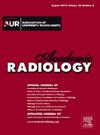Intra-individual Differences in Pericoronary Fat Attenuation Index Measurements Between Photon-counting and Energy-integrating Detector Computed Tomography
IF 3.8
2区 医学
Q1 RADIOLOGY, NUCLEAR MEDICINE & MEDICAL IMAGING
引用次数: 0
Abstract
Rationale and Objectives
The purpose of this study was to explore intra-individual differences in pericoronary adipose tissue (PCAT) fat attenuation index (FAI) between photon-counting detector (PCD)- and energy-integrating detector (EID)-CT.
Material and Methods
Patients were prospectively enrolled for a PCD-CT research scan within 30 days of EID-CT. Both acquisitions were reconstructed using a Qr36 kernel at 0.6 mm slice thickness (EID and PCD-down-sampled [DS]) and at 0.2 mm ultra-high resolution (UHR) for the PCD-CT. Iterative reconstruction was turned “off” (filter back projection used as alternative reconstruction method) or set to a recommended level in current literature. Coronary PCAT FAI was measured automatically using established thresholds of −190 to −30 HU at a set distance and radius. Statistical testing was performed using repeated-measures ANOVA and Bonferroni’s multiple comparison tests (p significance was determined to be <0.003).
Results
In total, 40 patients (mean age 68±8 years, 32 males [80%]) were included for analysis. Absolute FAI measurements differed significantly for all vessels between all reconstructions in the ANOVA comparison (all p<.001). The FAI decreased going from EID-CT to PCD-DS, to PCD-UHR with iterative reconstruction turned off (e.g. right coronary artery: EID-CT: −76.5±8.9 vs −80.9±7.0 vs −88.3±6.7 HU, respectively; p < 0.001). The mean FAI of datasets using iterative reconstruction did not demonstrate significant differences on multiple comparisons (e.g. left circumflex artery: EID: −65.7±8.5; PCD-DS: −66.0±7.4; PCD-UHR: −67.8±7.0 HU, respectively; p>0.06).
Conclusion
Intra-individual absolute PCAT FAI measurements differ significantly between EID- and PCD-CT when controlling for reconstruction kernel and slice thickness. However, the use of iterative reconstruction minimizes most differences in FAI, enabling inter-scanner comparability.
光子计数和能量积分检测器计算机断层扫描在冠状动脉脂肪衰减指数测量中的个体差异。
基本原理和目的:本研究的目的是探讨光子计数检测器(PCD)-和能量积分检测器(EID)- ct在冠状动脉周围脂肪组织(PCAT)脂肪衰减指数(FAI)的个体内差异。材料和方法:前瞻性招募患者在EID-CT后30天内进行PCD-CT研究扫描。使用Qr36内核在0.6 mm层厚(EID和pcd下采样[DS])和0.2 mm超高分辨率(UHR)对PCD-CT进行重建。在当前文献中,迭代重建被“关闭”(滤波反投影被用作替代重建方法)或设置为推荐级别。冠状动脉PCAT FAI在设定的距离和半径范围内使用-190至-30 HU的阈值自动测量。采用重复测量方差分析和Bonferroni多重比较检验进行统计学检验(p显著性为)结果:共纳入40例患者进行分析,平均年龄68±8岁,男性32例[80%]。在方差分析比较中,所有重建血管的绝对FAI测量值差异显著(均p0.06)。结论:在控制重建核和层厚时,EID- ct和PCD-CT的个体内绝对PCAT FAI测量值差异显著。然而,迭代重建的使用最小化了FAI的大多数差异,实现了扫描仪之间的可比性。
本文章由计算机程序翻译,如有差异,请以英文原文为准。
求助全文
约1分钟内获得全文
求助全文
来源期刊

Academic Radiology
医学-核医学
CiteScore
7.60
自引率
10.40%
发文量
432
审稿时长
18 days
期刊介绍:
Academic Radiology publishes original reports of clinical and laboratory investigations in diagnostic imaging, the diagnostic use of radioactive isotopes, computed tomography, positron emission tomography, magnetic resonance imaging, ultrasound, digital subtraction angiography, image-guided interventions and related techniques. It also includes brief technical reports describing original observations, techniques, and instrumental developments; state-of-the-art reports on clinical issues, new technology and other topics of current medical importance; meta-analyses; scientific studies and opinions on radiologic education; and letters to the Editor.
 求助内容:
求助内容: 应助结果提醒方式:
应助结果提醒方式:


